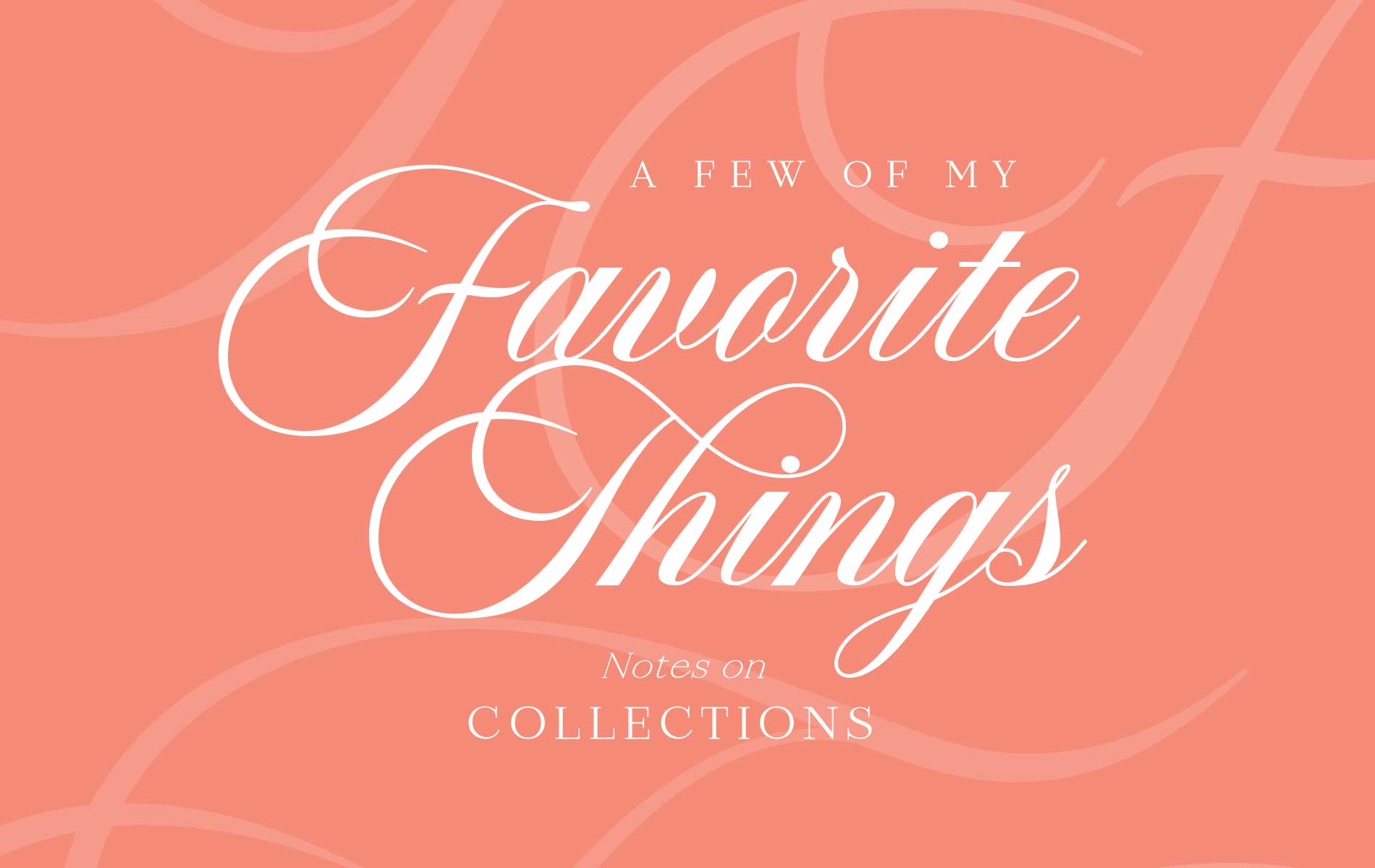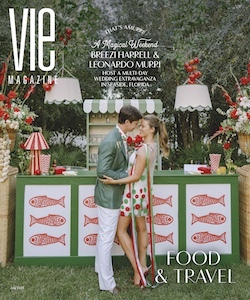
vie-magazine-suzanne-pollak
Notes on Collections
A Few of My Favorite Things
By Suzanne Pollak
The definition of a collector is this: a person who sees beauty in objects and wants to possess them, whether temporarily or for a lifetime. Being a passionate collector has elements of a love affair; both connect you with another and bring experiences of pleasure.
I find collectors intriguing, imaginative, complex, and creative. They seem to rely on intuition rather than logic. Collecting is a way to focus and help put things in order. I know this because I was once a collector. Their behaviors and habits have helped me understand myself.
Walter Benjamin says, “Perhaps the most deeply hidden motive of the person who collects can be described this way: he takes up the struggle against dispersion. Right from the start, the great collector is struck by the confusion, by the scatter, in which the things of the world are found.”
On Deciding What to Collect and When
Whether we have the brio of an heiress or the confidence of a young boy with pocket money, we can find objects we want to live with at any age. I began collecting as a child in Africa by peeling stamps off letters. A generation later, one of my sons was an aspiring collector in middle school; first Matchbox cars, then on to belt buckles, paid for by his weekend job at a car repair shop. His experience mirrored other collectors who desired to find the choicest objects and discard others as inferior or not up to snuff once he learned more. He faced another common collector dilemma when his belt buckle collection expanded in number: where do I store or display all the items? Yet another problem surfaced because of this particular collection; the size of the buckles themselves expanded, with some as large as salad plates! His imagined future growth must have played a role—a preteen wondering if he would ever be big enough to wear such belt buckles.
The Good, the Bad, and the Beautiful
The Good
A collector wants what the artist created. The collector “creates” a collection (an art form in itself) by spending personal treasure, taking time for research, meticulously caring for the objects, and appreciating what was created. The search is exhilarating, especially when finding the other half of a pair or a missing piece to complete a collection. One might do this by reading sales catalogs or scouring antique shops, all the time learning. All that is good, as one becomes a beauty connoisseur and educates oneself.
The Bad
Sometimes bad things happen to collected items, whether due to greed, addictions, or funds drying up. We once collected clocks—American grandfather clocks, dwarf or grandmother clocks, mantel clocks, shelf clocks, tavern clocks—but we never bought a lighthouse clock, and thank goodness for that. They are extremely rare and ridiculously pricey. This brings us to the dangerous part of collecting: not knowing when to stop. One risks becoming the definition of a collector who has been overcome by their addiction. Collectors can be subjected to a fog of thinking, “I must have this object,” or “I cannot control my desire.”
The Beautiful
Enter the world of interiors (and exterior rooms)—bathrooms, kitchens, dressing rooms, gardens, greenhouses, garages—all perfect settings for a collection. Collections make a room look entirely other, like transforming a powder room into a miniature hall of mirrors à la Versailles, a garden into a living, breathing exotic zoo (only more manageable), or a dressing room into a tea salon. One of my favorite collections was eighteenth-century American mirrors hung salon-style on dark, Coca Cola-colored glossy walls in a tiny powder room. Catching sight of yourself in the multiple wavy, reflective surfaces, often hard to see clearly because of the silvering mercury, was a dizzying sort of thrill. Your face came alive as you moved. The mirrors brought in light and beauty to a utilitarian room, covering the walls more imaginatively than wallpaper or paintings. The frames themselves were pieces of art. Since a bathroom is for being alone, one can focus on the decoration, observe, and admire, whether they are using the facilities, washing their hands, or applying lipstick.
Some collectors, especially financial heavyweights, go crazy. August the Strong commissioned a porcelain menagerie from Meissen for his pleasure palace. A collection of ghostly lions and tigers and bears, never seen alive in the Western world at that time, filled his orangery.
In 2000, a friend of mine with a Frank Lloyd Wright–designed house on a large piece of property collected exotic pheasants then built a Chinese pergola in his vast garden for housing and viewing them. Another friend bought exquisite shoes—not to wear, but for display in her dressing room, where she often drank tea at a dainty couch and table. The wall of open shelves was designed especially for showing off footwear as beautiful objets d’art. She rested her eyes on the slippers while sipping her tea.
The Life of a Collector
What is it like to always search for more, arrange, organize, hang things on walls, or place objects on tabletops and mantels? It’s pure satisfaction when you are a collector. Finding a place where the item has resonance with another takes time. You can spend years moving a picture or clock, a garniture set, a burled bowl. Put it here, and it sets the interior off magically; everything is harmonious and calming. Put it there, and the mood is gone; the thing looks like a bric-a-brac dust collector, not a priceless treasure.
There is an art to collecting. There is also an art and purpose to displaying. It might be the calibration of choosing which porcelain to use for tea, which plastic to cover hardbound books in to give your library an old-fashioned gleam, or which collection of prints or photographs to hang in a corridor.
The most enjoyable part of all is that particular moment in the day, perhaps late morning or afternoon, when the sun slants in and shines a golden light on your cherished collection.
Collections keep changing, whether it’s how they are displayed or how they grow, improve, and get dispersed. They can be a never-ending joy. Sadly, sometimes an end must come, and great loss is felt.
The Dispersion
All my collections have been dispersed, lost, or sold. I never planned to get rid of them; I loved them so. The decision was always made for me by uncontrollable circumstances. The stamp collection was left behind during an evacuation from the Biafran War.
Decades later, selling everything I collected was quite startling. It was strange seeing my furniture and porcelain in auction catalogs, photographed without the context of the room or their dialogue and relationship with objects living near and next to them. Off goes the porcelain, off goes the American furniture, off goes this and that beloved object, one lot after another. The things physically left my space and were wrenched from my brain. Over time, they morphed into cherished memories from the past, not obstacles holding me back from moving forward. Giving away pretty much everything opens up huge expanses to let in something new and welcome the future.
What I kept and why is a story for another day.
— V —
Suzanne Pollak, a mentor, and lecturer in the fields of home, hearth, and hospitality, is the founder and dean of the Charleston Academy of Domestic Pursuits. She is the coauthor of Entertaining for Dummies, The Pat Conroy Cookbook, and The Charleston Academy of Domestic Pursuits: A Handbook of Etiquette with Recipes. Born into a diplomatic family, Pollak was raised in Africa, where her parents hosted multiple parties every week. Her South Carolina homes have been featured in the Wall Street Journal Mansion section and Town & Country magazine. Visit CharlestonAcademy.com or contact her at Suzanne@CharlestonAcademy.com to learn more.
Share This Story!
KEEP UP WITH THE LATEST STORIES FROM VIE
















































































































































